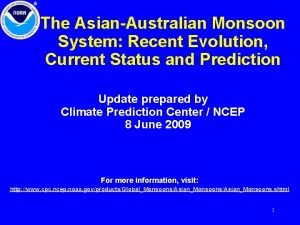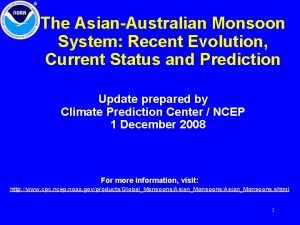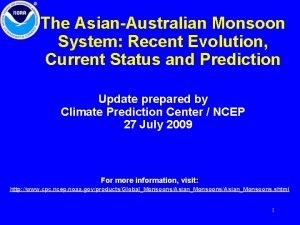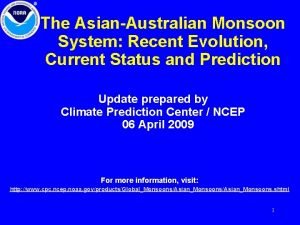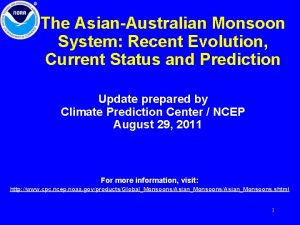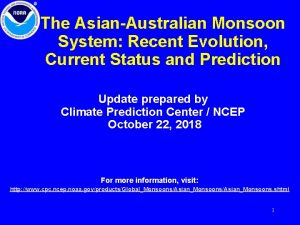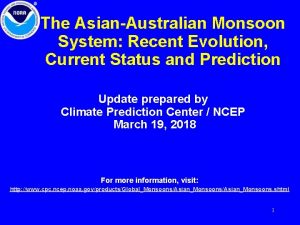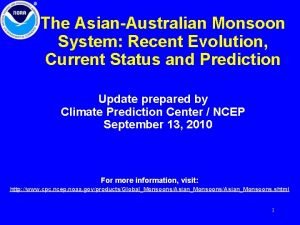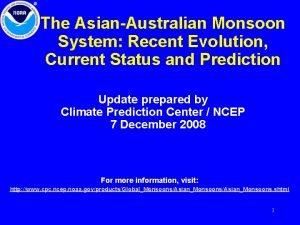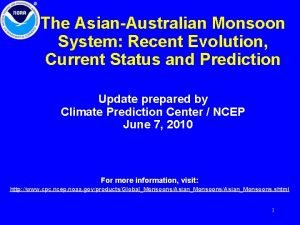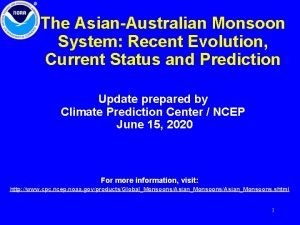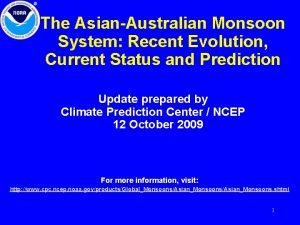The AsianAustralian Monsoon System Recent Evolution Current Status













- Slides: 13

The Asian-Australian Monsoon System: Recent Evolution, Current Status and Prediction Update prepared by Climate Prediction Center / NCEP 28 December 2009 For more information, visit: http: //www. cpc. ncep. noaa. gov/products/Global_Monsoons/Asian_Monsoons. shtml 1

Outline • Recent Evolution and Current Conditions • Monsoon Prediction • Summary • Climatology 2

OLR Patterns: Last 90 Days During the past 90 days, convection was overall suppressed over the Asian-Australian monsoon region except the enhanced convection over the tropical western Pacific Ocean and western Indian Ocean. 3

OLR Patterns: Last 30 Days During the past 30 days, convection was overall suppressed over the Asian-Australian monsoon region especially Southeast Asia. Enhanced convection was observed over the western Bay of Bengal, southern Arabian Sea, central tropical-southern Indian Ocean, and the western Pacific. 4

OLR Patterns: Last 5 Days The convection over Southeast Asia and northern Australia was overall near normal. Suppressed convection was observed over the South China Sea and far western Pacific and enhanced convection was seen over southern Arabian Sea, southern India, Sri Lanka, and tropical central southern Indian Ocean. 5

Rainfall Time Series over 5 x 5 lat-lon boxes The accumulated rainfall during the season has been below average over northeastern Australia but above or near average over northwestern Australia and much of Southeast Asia. 6

Atmospheric Circulation Anomalous anticyclones controlled much of Southeast Asia, and anomalous cyclonic pattern were observed over central equatorial and tropical-southern Indian Ocean. Convergent flow appeared over part of Indonesia and northern Australia. 7

NCEP/GFS Model Forecasts Bias-Corrected Precip. Anom. for Weak 1 & Week 2 Week-1 Week-2 8

Prediction of East Asia – NW Pacific Monsoon Upper panel: East Asia – Western North Pacific (EAWNP) monsoon index (Wang et al. 2008) defined as U 850 (5 -15ºN, 40 -80ºE) – U 850 (20 -30ºN, 70 -90ºE). Positive (negative) values indicate strong (weak) than normal monsoon. The NCEP Global Forecast System predicts that, in the next two weeks, the monsoon circulation over Southeast Asia and northwestern Pacific will be near normal. Lower panel: Correlation between rainfall and East Asia – Western North Pacific monsoon index (Wang et al. 2008; shading) and regression of 850 -mb winds on the monsoon index (vectors) for January. Green (brown) shading indicates increase (decrease) in rainfall associated with strong monsoon. 9

Prediction of Australian Monsoon Upper panel: Australian monsoon index (Hung and Yanai 2004) defined as U 850 averaged over 2. 5ºS-15ºS, 110 -150ºE. Positive (negative) values indicate strong (weak) than normal monsoon. The NCEP Global Forecast System predicts that, in the next two weeks, the Australian monsoon circulation will change from below normal in week-1 to above normal in week-2. Lower panel: Correlation between rainfall and Australian monsoon index (Hung and Yanai 2004; shading) and regression of 850 -mb winds on the monsoon index (vectors) for January. Green (brown) shading indicates increase (decrease) in rainfall associated with strong monsoon. 10

Summary • The convection over Southeast Asia and northern Australia was overall near normal. Suppressed convection was observed over the South China Sea and far western Pacific and enhanced convection was seen over southern Arabian Sea, southern India, Sri Lanka, and tropical central southern Indian Ocean. • The NCEP Global Forecast System predicts that in the next two weeks the Australian monsoon circulation will be moderately weaker than normal in week-1 and stronger than normal in week-2. 11

Onset of the Australia Monsoon 12

Climatology 13
 Y connected generator
Y connected generator Line current and phase current
Line current and phase current Drift current and diffusion current
Drift current and diffusion current Ac theory 3 lesson 4
Ac theory 3 lesson 4 Drift current
Drift current Drift current and diffusion current
Drift current and diffusion current A jfet always operates with
A jfet always operates with Line current and phase current
Line current and phase current Holding current and latching current
Holding current and latching current Drift current density unit
Drift current density unit In generators the welding current is produced on the ____.
In generators the welding current is produced on the ____. Hazard based safety engineering
Hazard based safety engineering Non planar circuit
Non planar circuit Cpsr register diagram
Cpsr register diagram














